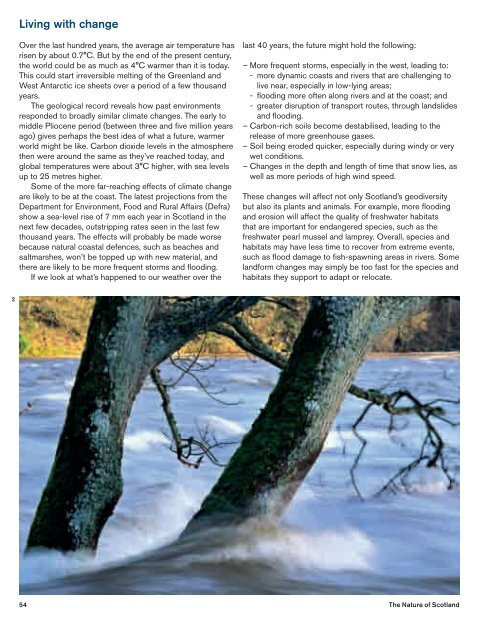Summer 2009 - Scottish Natural Heritage
Summer 2009 - Scottish Natural Heritage
Summer 2009 - Scottish Natural Heritage
You also want an ePaper? Increase the reach of your titles
YUMPU automatically turns print PDFs into web optimized ePapers that Google loves.
Living with change<br />
Over the last hundred years, the average air temperature has<br />
risen by about 0.7°C. But by the end of the present century,<br />
the world could be as much as 4°C warmer than it is today.<br />
This could start irreversible melting of the Greenland and<br />
West Antarctic ice sheets over a period of a few thousand<br />
years.<br />
The geological record reveals how past environments<br />
responded to broadly similar climate changes. The early to<br />
middle Pliocene period (between three and fi ve million years<br />
ago) gives perhaps the best idea of what a future, warmer<br />
world might be like. Carbon dioxide levels in the atmosphere<br />
then were around the same as they’ve reached today, and<br />
global temperatures were about 3°C higher, with sea levels<br />
up to 25 metres higher.<br />
Some of the more far-reaching effects of climate change<br />
are likely to be at the coast. The latest projections from the<br />
Department for Environment, Food and Rural Affairs (Defra)<br />
show a sea-level rise of 7 mm each year in Scotland in the<br />
next few decades, outstripping rates seen in the last few<br />
thousand years. The effects will probably be made worse<br />
because natural coastal defences, such as beaches and<br />
saltmarshes, won’t be topped up with new material, and<br />
there are likely to be more frequent storms and fl ooding.<br />
If we look at what’s happened to our weather over the<br />
last 40 years, the future might hold the following:<br />
– More frequent storms, especially in the west, leading to:<br />
- more dynamic coasts and rivers that are challenging to<br />
live near, especially in low-lying areas;<br />
- fl ooding more often along rivers and at the coast; and<br />
- greater disruption of transport routes, through landslides<br />
and fl ooding.<br />
– Carbon-rich soils become destabilised, leading to the<br />
release of more greenhouse gases.<br />
– Soil being eroded quicker, especially during windy or very<br />
wet conditions.<br />
– Changes in the depth and length of time that snow lies, as<br />
well as more periods of high wind speed.<br />
These changes will affect not only Scotland’s geodiversity<br />
but also its plants and animals. For example, more fl ooding<br />
and erosion will affect the quality of freshwater habitats<br />
that are important for endangered species, such as the<br />
freshwater pearl mussel and lamprey. Overall, species and<br />
habitats may have less time to recover from extreme events,<br />
such as fl ood damage to fi sh-spawning areas in rivers. Some<br />
landform changes may simply be too fast for the species and<br />
habitats they support to adapt or relocate.<br />
2<br />
54 The Nature of Scotland

















